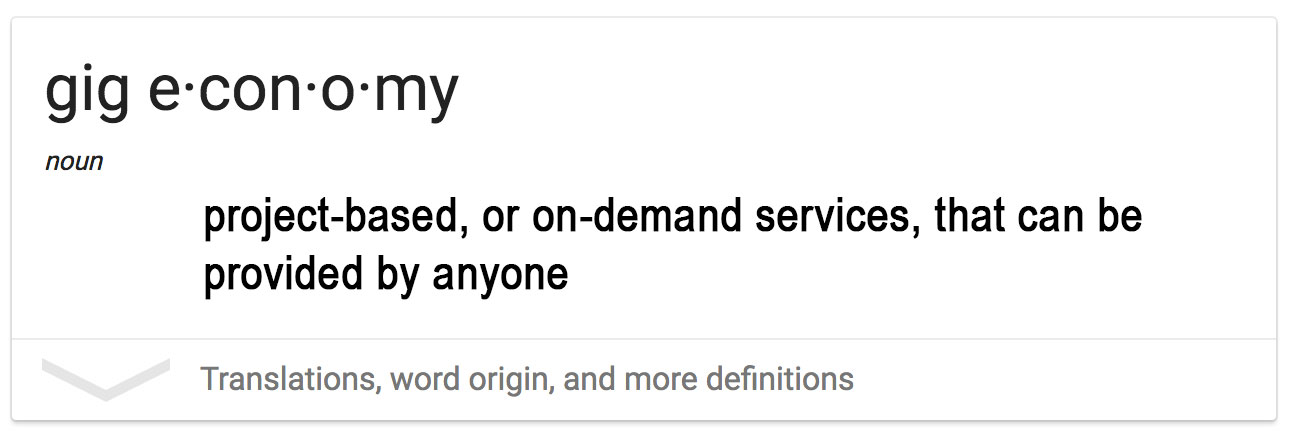

By 2027, over 50% of the US workforce will probably participate in the gig economy.Įven though the prognosis about the gig economy’s future is excellent, and what today’s market is bringing to the table creates a liberated workforce, some issues and concerns will have to be addressed. 29% of employees have some work on the side, and 36% of US employees enjoy gig job opportunities. Yet the scale and scope of these changes is hard to assess, because conventional labour market statistics and economic indicators are ill-suited to measuring. The gig economy provides them with enough flexibility to organize their tasks, find more job opportunities, and generate higher income.Īccording to statistics, the gig economy expands three times faster than the whole US workforce.

#Gigeconomy online statistics free#
They don’t have to think about landing one ideal job position and can enjoy more free time to develop their skills and expand service offerings. On the other hand, gig workers have a variety of clients, some of which are recurring. Keywords: commodification digital labor gig economy online outsourcing. They can enjoy the expert service they don’t have to use regularly, workforce agility, and reduced healthcare costs. Multivariate statistics techniques have been applied for data analyses (e.g. Companies don’t have to think about hiring employees for permanent job positions, designating the office space, or providing training sessions if necessary. The gig economy brings benefits to both sides. With so many platforms where gig workers offer their services, businesses can find temporary employees online and hire them for online or in-house jobs. The services can include almost everything, from optimizing a website to office interior design. Furthermore, One-third of the world’s workforce is within this growing industry, and experts predict that in the US, 60 of all workers will be independent by the year 2027. (1) More than half of full-time freelancers state that they are more financially secure than they would be if they were working in a traditional job. Gig economy statistics presented by Global Workplace Analytics in 2020 show a 159 growth rate of remote work in the last 12 years and 44 in the past five years. (1) 53 of people between the ages of 18 and 34 who work in the gig economy use it as their primary income source. New technological advancements, like online platforms and communication tools, provided the perfect environment for gig workers to offer their services online. 44 of people working in the gig economy use it as their primary source of income. Instead, companies are turning to temporary workers who can finish a job and leave. As a temporary work assignment, gigs don’t demand full-time employees. Instead of traditional employment, gigs have become extremely popular. Defined as a free market system where temporary job positions are common, and businesses hire workers for short-term projects, the gig economy is on a path to change how the workforce is hired. To benefit policymakers, labour market researchers and the general public, our results are published in an interactive online visualisation which is updated daily.Traditional employment might soon make room for the gig economy. We also demonstrate how it can be used to address previously unanswered questions about the online gig economy. The purpose of this article is to introduce the OLI and describe the methodology behind it.

and sell their services online on different platforms or companies. It measures the utilization of online labour across countries and occupations by tracking the number of projects and tasks posted on major online gig platforms in near-real time. Gig Economy, also referred to as crowdsourcing, the sharing economy and the. for gig workers and statistics to illustrate gig economy activity in Florida at. We present the Online Labour Index (OLI), an experimental economic indicator that approximates the conventional labour market statistic of new open vacancies. The terms gig, sharing or online economy are often used to describe the. Yet the scale and scope of these changes is hard to assess, because conventional labour market statistics and economic indicators are ill-suited to measuring this “online gig work”. Labour markets are thought to be in the midst of a dramatic transformation, where standard employment is increasingly supplemented or substituted by temporary work mediated by online platforms.


 0 kommentar(er)
0 kommentar(er)
